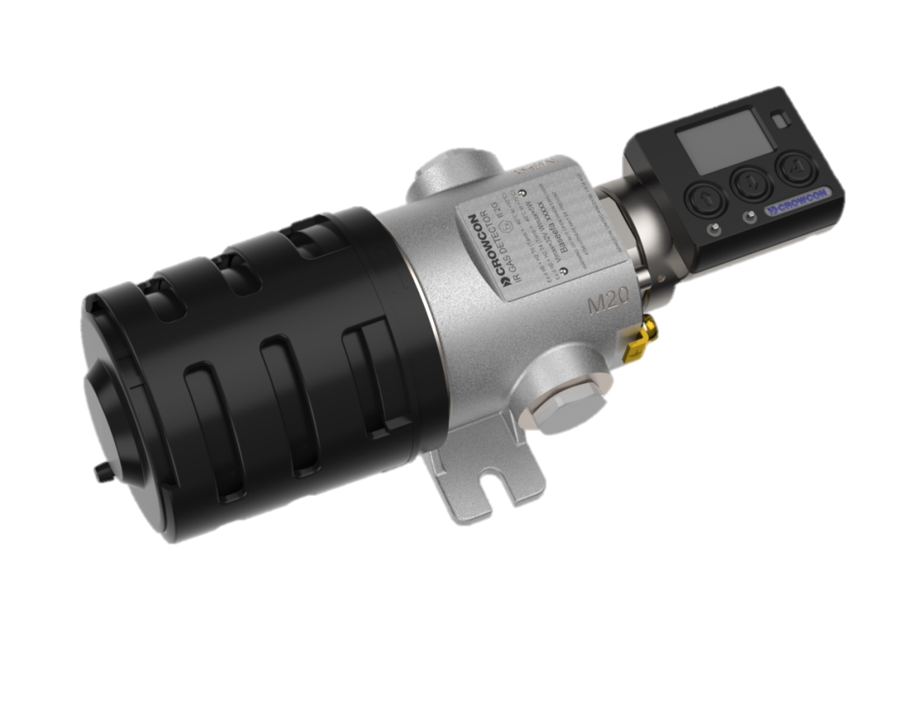Jak działają czujniki podczerwieni
Czujniki podczerwieni (IR) wykrywają stężenie gazu poprzez pomiar absorpcji światła podczerwonego o określonej długości fali. Wiązka światła podczerwonego przechodzi przez gaz i dociera do optyki zbierającej, która rozdziela wiązkę i kieruje ją przez filtry do detektorów podczerwieni.
- Wiązka pomiarowa (około 3,3 μm) jest pochłaniana przez gazy, takie jak węglowodory, co zmniejsza jej intensywność.
- Wiązka referencyjna (około 3,0 μm) pozostaje nienaruszona i dociera do detektora z pełną mocą.
Porównując intensywność dwóch wiązek, czujnik podczerwieni określa stężenie gazu docelowego, zwykle wyrażone jako procent dolnej granicy wybuchowości (LEL).
- Dokładność
Czujniki podczerwieni zapewniają doskonałą dokładność wykrywania gazów, takich jak węglowodory i dwutlenek węgla. Ich wydajność pozostaje stabilna nawet w środowiskach o niskiej zawartości tlenu, które mogłyby wyłączyć czujniki pelistorowe. Jednak kalibracja pod kątem konkretnego rodzaju wykrywanego gazu ma kluczowe znaczenie dla utrzymania dokładności, zwłaszcza w przypadku obecności wielu rodzajów gazu. W przeciwieństwie do czujników pelistorowych, czujniki podczerwieni są odporne na zatrucie substancjami chemicznymi, takimi jak siarka lub ołów, co czyni je bardziej trwałymi w niektórych zastosowaniach.
- Niezawodność
Czujniki podczerwieni są wysoce niezawodne w wykrywaniu gazów w środowiskach, w których czujniki katalityczne mogą zawieść, takich jak atmosfera uboga w tlen lub obszary o wysokim stężeniu gazów zakłócających. Ponadto czujniki podczerwieni nie są podatne na zatrucia lub "sadzę" z paliw węglowodorowych, które mogą poważnie ograniczyć funkcjonalność czujników pelistorowych. Dzięki mniejszej liczbie czynności konserwacyjnych i dłuższej żywotności, czujniki podczerwieni stanowią bezpieczniejsze i trwalsze rozwiązanie dla wielu branż.
- Konserwacja
Czujniki podczerwieni generalnie wymagają rzadszej konserwacji niż inne czujniki. Są one odporne na zatrucia chemiczne i nie cierpią z powodu takich samych problemów z degradacją. Regularna kalibracja jest nadal zalecana w celu zapewnienia dokładnych odczytów, zwłaszcza w środowiskach o dużym natężeniu ruchu. Czujniki podczerwieni wymagają również znacznie mniej energii niż inne czujniki, dzięki czemu idealnie nadają się do zastosowań o ograniczonej dostępności energii.
Ograniczenia czujników podczerwieni
- Wymaga kalibracji dla określonych gazów
- Może się nasycać przy bardzo wysokich stężeniach gazu
- Droższe niż czujniki pelistorowe
Zastosowania czujników podczerwieni
Poznaj powiązane produkty
Subskrybuj, aby otrzymywać najnowsze informacje
w swojej skrzynce odbiorczej
Przeczytaj o Crowcon Prywatność i Polityka plików cookie tutaj. Jeśli zmienisz zdanie, możesz zrezygnować z subskrypcji w dowolnym momencie



